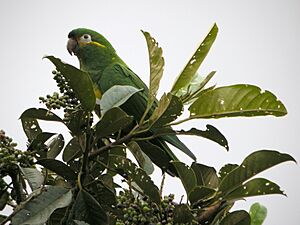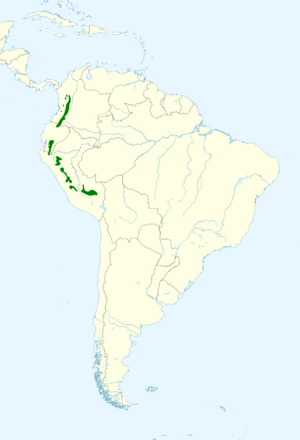Golden-plumed parakeet facts for kids
Quick facts for kids Golden-plumed parakeet |
|
|---|---|
 |
|
| In Tapichalaca Reserve, Ecuador | |
| Conservation status | |
| Scientific classification | |
| Genus: |
Leptosittaca
|
| Species: |
branickii
|
 |
|
The Golden-plumed Parakeet (Leptosittaca branickii) is a beautiful parrot that lives in the mountains of South America. You can find these bright green birds in the humid forests of Colombia, Ecuador, and Peru. They are quite rare and face threats from habitat loss. This special parakeet is the only known parrot that can see ultraviolet radiation!
Contents
What Does the Golden-plumed Parakeet Look Like?
The Golden-plumed Parakeet is a large parrot with a long tail. It lives in the cloud forests high up in the Andes mountains. Adult parakeets are mostly bright green. They have orangish-yellow patches near their eyes and small golden-yellow crests behind their eyes.
Their bellies are a lighter yellowish color with some reddish-orange feathers mixed in. The feathers under their wings are yellowish, and the feathers under their tail are a strong reddish color. Young parakeets look a lot like the adults. However, their bellies are a paler green, yellow, and orange, and their beaks are light pink.
How Do Golden-plumed Parakeets Behave?
Golden-plumed Parakeets usually live in groups of 5 to 15 birds. Sometimes, you might even see very large groups with 35 to 40 birds! They often move around, especially after their chicks leave the nest. They will then return to the same area for the next breeding season.
These parakeets like to sit on exposed branches or on top of tall Wax palms. They are very noisy birds! Their call is a loud, shrill sound. You can hear them calling while they fly or when they are resting. They call all year round, but even more often during the breeding season, especially near their nesting spots.
Golden-plumed Parakeet Reproduction
When male and female parakeets mate, they sit on the same branch and slowly move closer to each other. The male then gently climbs onto the female's back. Both birds raise their long tails and rub their cloacas together. This is how birds mate. They will shake their tails for about one to two minutes.
What Do Golden-plumed Parakeets Eat?
Golden-plumed Parakeets rely on Wax palms for shelter. They also depend a lot on Podocarpus cones for their food. They spend much of their time looking for food in Podocarpus trees. These are a type of conifer tree, sometimes called the African fern tree.
Why Are Golden-plumed Parakeets Endangered?
The biggest threats to the Golden-plumed Parakeet are the destruction and breaking up of their forest homes. This is causing their numbers to drop in places like Ecuador. Today, there are only about 7,300 to 20,000 adult Golden-plumed Parakeets left. This is mainly because their habitat is being lost and divided into smaller pieces.
There are special conservation areas throughout their region. These places are working hard to help protect these beautiful birds and their homes.
Predators of the Golden-plumed Parakeet
Sometimes, other animals prey on the eggs and chicks of Golden-plumed Parakeets. For example, Andean weasels have been known to eat eggs and young chicks. They have even attacked adult parakeets.
Another problem for nesting parakeets is the western honeybee. Bees sometimes take over nesting cavities. They can occupy empty nests or even nests where parakeet chicks are already living. This competition for nesting spots can make it harder for the parakeets to successfully raise their young.


